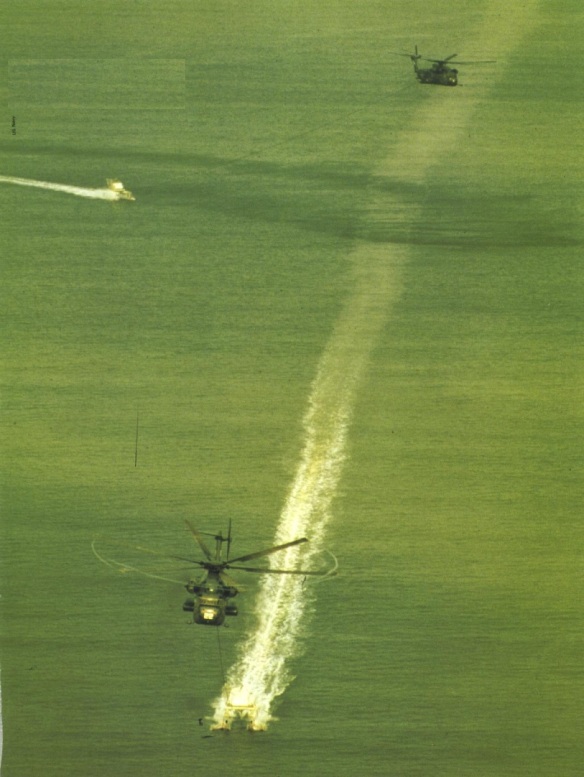The MH-53E Sea Dragon mine countermeasures helicopter was developed for the US Navy to replace RH-53Ds. Identifiable by their extra large composite construction sponsons which house extra fuel, the MH-53Es tow a hydrofoil sledge carrying mechanical, acoustic and magnetic sensors for mine detection.
The Japanese Maritime Self Defense Force retired the Sikorsky MH-53E Sea Dragon (export designation S-80M-1) on March 3, 2017. On February 20, 111 Kokutai carried out its last training flight on aircraft serial number 8625 from Marine Corps Air Station Iwakuni. Japan is the sole export customer for the Sea Dragon, operating 11 airframes since 1989. In May 2015, the US Navy signed a contract to purchase two decommissioned MH-53Es from Japan for parts, including 12 engines and two tow booms. Agusta-Westland MCM-101 Merlins now conduct the duties once performed by the Sea Dragon using the AQS-24A airborne mine hunting system: the AES-1 airborne laser mine detection system and the Mk104 acoustic mine-sweeping device.
On December 23, 1981, Sikorsky produced the latest in the CH- 53 series, the MH-53E Sea Dragon, Airborne Mine Counter Measure (AMCM) helicopter. Sikorsky engineers provided the Sea Dragon with an additional 1,000 gallons of fuel, along with a modified electrical and hydraulic system to accommodate the mine-sweeping equipment towed behind the aircraft on a floating sled. Additional Sea Dragon duties include shipboard replenishment with both internal and external cargo and SAR missions.
The MH-53E is based on aircraft carriers and other warships and is an upgrade modification of the CH-53E Super Stallion, offering more power and endurance than the Super Stallion. The MH-53E can carry 55 troops. It can carry a 16-ton payload for a distance of 50 nautical miles or a 10-ton payload for a distance of 500 nautical miles. Additionally, the aircraft can tow a variety of mine-sweeping countermeasures systems.
The MH-53E Sea Dragon first flew in 1982 and is the largest helicopter in the West. It is propelled by three General Electric T64-GE-416 turboshaft engines and has a range of 1,120 nautical miles. Ceiling is 27,900 feet, top speed, 172 miles per hour. It is crewed by two pilots and one to six crewmen, depending on mission.
Specification
The Sikorsky-built MH-53E Sea Dragon, a mine countermeasures derivative of the CH-53E Super Stallion, is heavier and has a greater fuel capacity and range. Capable of transporting up to 55 troops, the MH-53E can carry a 16-ton payload 50 nautical miles or a 10-ton payload 300 nautical miles. In its primary mission, the MH-53E is capable of towing a variety of mine countermeasures systems, including the MK-105 magnetic mine-sweeping sled, the AQS-24A side-scan sonar and the MK-103 mechanical mine-sweeping system. Mission duration can exceed four hours. All MH-53E aircraft employ the T64-GE-419 engines. The fleet of MH-53Es is being modifed with crash-attenuating crew and troop seats, Helicopter Emergency Egress Lighting Systems and Blue Force Tracker for situational awareness.
MH-53Es provide mine-sweeping and strike group logistics support for worldwide military operations and humanitarian assistance. The Navy operates 28 MH-53Es in two helicopter mine countermeasures squadrons, HM-14 and HM-15, and one fleet replacement squadron, HM-12. Two retired MH-53Es were acquired from Japan in 2015 for spare parts. The operational squadrons are manned by an 80/20 mix of active and Reserve personnel.
FUSELAGE LENGTH: . . . . . 73.3 feet
OVERALL LENGTH:. . . . . . . 99 feet
HEIGHT: . . . . . . . . . . . . . . . . .28.3 feet
WEIGHT: . . . . . . . . . . . . . . . . empty, 36,745 pounds; maximum gross, 69,750 pounds
MAX SPEED: . . . . . . . . . . . . .172 miles/hour (150 knots)
MAX MISSION RADIUS: . . . …272 statute miles (237 nautical miles) with 32 troops at 3,000 feet
POWER PLANT: . . . . . . . . . . .3 General Electric T64-GE-419 turboshaft engines (4,750 shp each)
CREW: . . . . . . . . . . . . . . . . . .2 pilots, 1-6 aircrew, depending on mission
ARMAMENT:. . . . . . . . . . . . . ..1 GAU-21, 2 XM-218 .50-caliber machine guns
CONTRACTOR: . . . . . . . . . . .Sikorsky Aircraf Corp.
AN/AQS-14 and AN/AQS-14A (Aviation Systems) – The AN/AQS-14, an active-controlled, helicopter-towed mine-hunting sonar, is currently used in MH-53E Sea Dragon helicopters. It is a multi-beam, side-looking sonar with electronic beam forming, all-range focusing, and an adaptive processor. The system consists of three parts: a stabilized underwater vehicle, electro-mechanical tow cable, and airborne electronic console. The 10.7-foot long underwater vehicle can be maintained at a fixed depth above the seafloor or below the surface, and the thin, coaxial cable is armored and nonmagnetic. Sonar information is presented on two continuous waterfall displays. An upgrade to the AN/AQS-14 system, the AN/AQS-14A, modifies the airborne electronics from an analog to a digital system and increases the size of the operator’s monitor. A Post Mission Analysis (PMA) station has been incorporated into the system for use with the contact tapes after the mission is complete to identify and classify mine-like contacts.
AN/AQS-20 – The AN/AQS-20 is a helicopter-towed mine-hunting sonar consisting of a Mission Control Display Subsystem, an AMCM Console Subsystem located in the helicopter, and a Towed Body Subsystem. The towed body includes side-looking, gap-filling, volume-searching, and forward-looking sonars. The AQS-20 will be effective against bottom and moored mines in both deep and shallow waters. It will provide an increase in area coverage rate in comparison to the current AQS-14 system and can provide single-pass detection of both bottom and moored mines. Six of these systems were fitted to MH-53E Sea Dragon helicopters.
